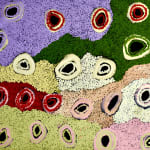May Mayiwalku (May Wokka) Chapman Australian, Manyjilyjarra , b. 1940
Water All Around, 2020
acrylic on canvas
101.5 x 91.5 cm
20-255
'Waterhole, claypan, river here. Water. Take the water, dig him out. drink him (motions cupping hands hands to scoop water and drink it). He clean water! Claypan here, waterhole. Water...
"Waterhole, claypan, river here. Water. Take the water, dig him out. drink him (motions cupping hands hands to scoop water and drink it). He clean water! Claypan here, waterhole. Water l'Il drink him here. Get him, get him, get him, drink him! (May motions digging in the sand to reach the water source, then cups her hands to mimic drinking). We find him in the spinifex. Water coming- clean water. Plenty water! Big mob. Stay there long time, then walk around everywhere.”
- May Wokka (Mayiwalku) Chapman
In this account Mayiwalku describes various types of water sources found in the desert and the ways in which water was obtained from these sources. During the pujiman (desert dwelling, nomadic) period, the survival of Aboriginal people living in Australia's harsh arid zones depended on their knowledge of the location of thousands of life sustaining water bodies, encompassing even the the location of subterranean waterways. Seasonally, small family groups would move from place to place depending on the availability of food and water. Though rainfall was generally low and unpredictable, the annual wet season would see claypans filled and soaks replenished, allowing larger groups to gather for meetings, initiations, marriages, exchanges of materials, and the performance of rituals.
- May Wokka (Mayiwalku) Chapman
In this account Mayiwalku describes various types of water sources found in the desert and the ways in which water was obtained from these sources. During the pujiman (desert dwelling, nomadic) period, the survival of Aboriginal people living in Australia's harsh arid zones depended on their knowledge of the location of thousands of life sustaining water bodies, encompassing even the the location of subterranean waterways. Seasonally, small family groups would move from place to place depending on the availability of food and water. Though rainfall was generally low and unpredictable, the annual wet season would see claypans filled and soaks replenished, allowing larger groups to gather for meetings, initiations, marriages, exchanges of materials, and the performance of rituals.



